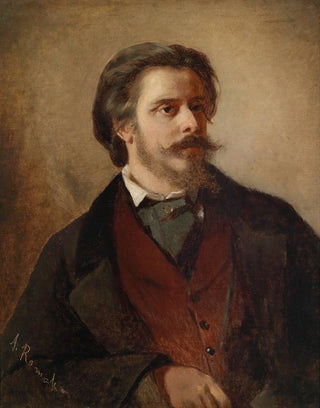Art print | Portrait of the painter Berthold Winder - Anton Romako


View from behind

Frame (optional)
Portrait of the painter Berthold Winder - Anton Romako – Captivating introduction
In the fascinating world of art, some works stand out for their ability to capture the very essence of humanity. The "Portrait of the painter Berthold Winder" by Anton Romako is a striking example. This painting, which transcends mere representation, immerses us in the intimacy of an artist while revealing the subtleties of his era. Through this art print, Romako does not just depict a face; he tells a story, that of a man and a creator, inviting us to explore the depths of human creativity. The art print of this iconic piece allows appreciation of the richness of emotions and details hidden within.
Style and uniqueness of the work
Anton Romako's style is characterized by a realistic approach and meticulous attention to detail. In the "Portrait of the painter Berthold Winder," each brushstroke seems charged with meaning, each shadow and light contribute to creating a unique atmosphere. The color palette chosen by the artist evokes a gentle melancholy, while the model's posture, both serene and reflective, invites us to deep contemplation. Romako succeeds in capturing not only Winder's physical appearance but also the intensity of his creative spirit. The work stands out for its skill in blending reality and subjectivity, offering a vision that is both personal and universal of the artist. This portrait, a true mirror of the soul, explores themes of identity, passion, and artistic quest.
The artist and his influence
Anton Romako, born in 1832, was an Austrian painter whose work was profoundly influenced by the Romantic movement. His career, marked by an unceasing quest for beauty and truth, led him to explore various genres, from portraiture to history painting. In the "Portrait of the painter Berthold Winder," Romako demonstrates his skill in capturing not only the physical appearance of his subjects but also their inner essence. His influence is felt not only through his works but also by his ability to inspire other artists. By integrating

Matte finish

View from behind

Frame (optional)
Portrait of the painter Berthold Winder - Anton Romako – Captivating introduction
In the fascinating world of art, some works stand out for their ability to capture the very essence of humanity. The "Portrait of the painter Berthold Winder" by Anton Romako is a striking example. This painting, which transcends mere representation, immerses us in the intimacy of an artist while revealing the subtleties of his era. Through this art print, Romako does not just depict a face; he tells a story, that of a man and a creator, inviting us to explore the depths of human creativity. The art print of this iconic piece allows appreciation of the richness of emotions and details hidden within.
Style and uniqueness of the work
Anton Romako's style is characterized by a realistic approach and meticulous attention to detail. In the "Portrait of the painter Berthold Winder," each brushstroke seems charged with meaning, each shadow and light contribute to creating a unique atmosphere. The color palette chosen by the artist evokes a gentle melancholy, while the model's posture, both serene and reflective, invites us to deep contemplation. Romako succeeds in capturing not only Winder's physical appearance but also the intensity of his creative spirit. The work stands out for its skill in blending reality and subjectivity, offering a vision that is both personal and universal of the artist. This portrait, a true mirror of the soul, explores themes of identity, passion, and artistic quest.
The artist and his influence
Anton Romako, born in 1832, was an Austrian painter whose work was profoundly influenced by the Romantic movement. His career, marked by an unceasing quest for beauty and truth, led him to explore various genres, from portraiture to history painting. In the "Portrait of the painter Berthold Winder," Romako demonstrates his skill in capturing not only the physical appearance of his subjects but also their inner essence. His influence is felt not only through his works but also by his ability to inspire other artists. By integrating






